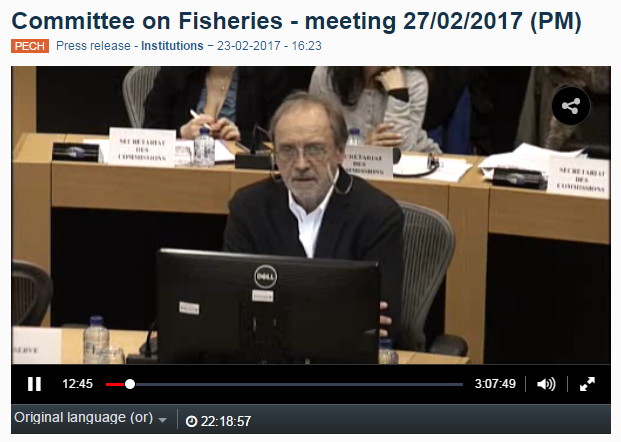 Come parte del loro incontro in programma il 27 febbraio 2017, la commissione per la pesca del Parlamento europeo ha convocato una audizione pubblica di esperti al fine di ascoltare gli specialisti invitati sullo stato e lo sviluppo degli stock ittici gestiti dalla politica comune della pesca (PCP). Il primo esperto a parlare è stato il dottor Rainer Froese, Senior Scientist al GEOMAR di Kiel.
Come parte del loro incontro in programma il 27 febbraio 2017, la commissione per la pesca del Parlamento europeo ha convocato una audizione pubblica di esperti al fine di ascoltare gli specialisti invitati sullo stato e lo sviluppo degli stock ittici gestiti dalla politica comune della pesca (PCP). Il primo esperto a parlare è stato il dottor Rainer Froese, Senior Scientist al GEOMAR di Kiel.
Dr. Froese is renowned for being one of the fathers of FishBase and excelling with important studies for sustainable and profitable fisheries. He started with a reminder of the most frequently used terms:
MSY is the maximum sustainable yield, the maximum long-term catch
Bmsy is the smallest biomass that can produce MSY
F is the fishing mortality rate, the proportion of fish in a population killed by fishing
Fmsy is the fishing mortality rate resulting eventually in Bmsy and MSY
Bpa is the border of safe biological limits, the biomass below which recruitment may be impaired.
He briefly recalled the most comprehensive study so far he had conducted with an international team of independent scientists about the status of 397 stocks in European waters. The study had found that about 60 of these stocks had population sizes in the green area, which allows to produce high yields on a sustainable basis and gave fishers a good income, but the vast majority needed recovery measures to comply with the provisions of the Common Fisheries Policy (CFP).
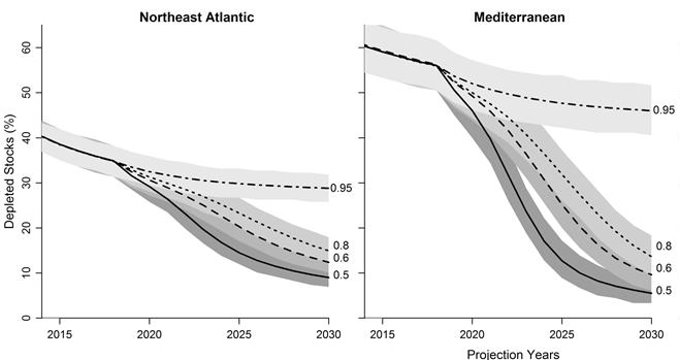
He then turned the attention to how to get to high population sizes for those stocks falling short. In the Northeast Atlantic where approximately 40% of the stocks are hovering around the limit of safe biological limits it turns out that continued high fishing pressure close to that needed for maximum sustainable yield (Fmsy) recovery is very slow and not achievable for most of them by 2030. A similar picture arises for the Mediterranean where the vast majority of stocks are depleted and at levels that pose problems for recruitment of the next generation.

The encouraging message is though that cutting down fishing pressure (and therefore also costs) has excellent potential for recovery, even within a relatively short number of years. When fishing pressure were to be halved, all but a small fraction of stocks would recover into the green area by 2030!
 Dr. Froese then went on to look into profitability of fishing operations. The last data are officially available for 2014 from the Scientific,Technical and Economic Committee for Fisheries (STECF), an official advisory body to the European Commission.
Dr. Froese then went on to look into profitability of fishing operations. The last data are officially available for 2014 from the Scientific,Technical and Economic Committee for Fisheries (STECF), an official advisory body to the European Commission.
The scenarios show that profitability could increase by 150% in NE Atlantic fisheries from the 2014 level if fishing pressure were reduced and population sizes recovered. Given the very low current profitability in depressed Mediterranean fisheries, even modest reductions of fishing pressure would triple profitability by 2030.
Given the relatively fast expected recovery under a prudent management regime as required by the CFP the transition should pay off early on. At a high level of recovery an estimated five million tons more fish and fishery products could be sustainably harvested.
Dr. Froese summarised the research findings in a few bullet points - click here for the full presentation:
- Sustainable exploitation by 2015 has been achieved for only 1/3 of the stocks
- In 2015, biomass was above the MSY level in only 15% of the stocks
- Fastest rebuilding is achieved with F = 0.5 Fmsy
- High profitability is achieved with F = 0.5 - 0.8 Fmsy
- F = 0.95 Fmsy fails to rebuild depleted stocks and results in lowest profitability
- Sustainable catches can be 5 MT (> 50%) higher if stocks are rebuilt above MSY levels
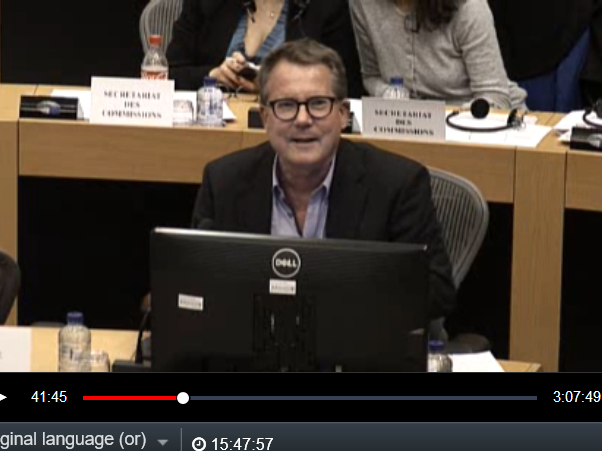 The second expert to take the floor was Dr. John Pope. He is a long-serving official of the UK Ministry of Agriculture, Fisheries and Food, who is now retired and works as a consultant. He reported about findings from the research project focused on the ecosystem approach to fisheries and underscored the importance to account for ecosystem interactions. He cautioned that while the general message was clear in that rebuilding bigger populations were able to generate higher catches on a long-term basis, but that not all of that was available for the fisheries because of species interactions within the ecosystem. He also argued in favour of simplifying the presentation of the science so that more ordinary citizens could understand the research process and its results.
The second expert to take the floor was Dr. John Pope. He is a long-serving official of the UK Ministry of Agriculture, Fisheries and Food, who is now retired and works as a consultant. He reported about findings from the research project focused on the ecosystem approach to fisheries and underscored the importance to account for ecosystem interactions. He cautioned that while the general message was clear in that rebuilding bigger populations were able to generate higher catches on a long-term basis, but that not all of that was available for the fisheries because of species interactions within the ecosystem. He also argued in favour of simplifying the presentation of the science so that more ordinary citizens could understand the research process and its results.
Next to speak was Michael Andersen of the Danish Fishermen Producer Organisation. He disapproved of the notion that many stocks in Europe were overfished. He and emphasised that the general trend was now for some improvement and that the speed was not important, only the trend. He submitted that reductions in fishing pressure would increase the problems of the industry which was already losing jobs and vessels.
So long as the stocks were not further reduced below safe biological limits, fishing had to continue to keep jobs in the industry. Nobody could wait fifteen years for the stocks to be in perfect shape. The import point was "not to fall off the cliff". Rather than rigid legal targets there was a need for more flexibility and a roadmap of how to get to the targets.
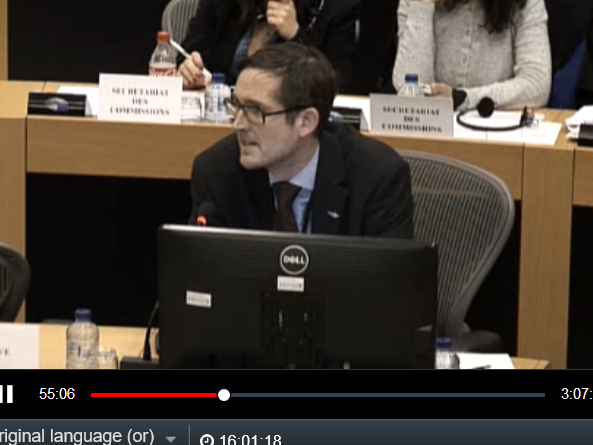 The last expert speaker to take the floor was Markus Knigge, Senior Adviser to Pew Charitable Trusts' Marine Programme and well familiar with the policy reform process which he had helped to accompany through the Ocean2012 civil society coalition.
The last expert speaker to take the floor was Markus Knigge, Senior Adviser to Pew Charitable Trusts' Marine Programme and well familiar with the policy reform process which he had helped to accompany through the Ocean2012 civil society coalition.
Markus Knigge welcomed the hearing as a timely way to start assessing whether the CFP reform was achieving its objectives laid out in Articles 2.2 and 9 and thus ending overfishing and ensuring economic viability.
He objected to being satisfied with a stock population status what was just above collapse.
He cited a World Bank study that estimated an additional US$12.5 billion higher value for European fisheries if they were managed more prudently and stocks allowed to recover.
He welcomed the idea of a roadmap, but cautioned that the objective of ending overfishing by 2015 at the latest had been enshrined in many previous decisions, such as the Johannesburg Plan of Action adopted by Heads of State and Government in 2002, but that 2/3 of European stocks were still not in good conditions.
 He feared that the provisions for flexibility that were already part of the policy in cases of serious socio-economic distress for the fishing industry to delay reductions of fishing effort had never officially played a role in decisions of the Council of European Ministers in charge of Fisheries when delaying measures or deciding on exceptions.
He feared that the provisions for flexibility that were already part of the policy in cases of serious socio-economic distress for the fishing industry to delay reductions of fishing effort had never officially played a role in decisions of the Council of European Ministers in charge of Fisheries when delaying measures or deciding on exceptions.
He cautioned that the Multi-annual Plan (MAP) for the Baltic was again allowing for overfishing as decided by the Council. An evaluation of progress towards the biomass objective (Bmsy) was still outstanding and it seemed the Commission had not asked ICES as one of its major scientific advisory bodies for an update of its advice on MSY after the adoption of the policy reform in 2013.
His concluding recommendation was threefold:
- define Fmsy as a limit point. Fishing in the upper range very close to Fmsy will not allow stocks to recover to population sizes enabling MSY (Bmsy)
- oppose the so-called "precautionary" level as a management objective as it just prevents total collapse, but not the achievement of Bmsy
- publish comprehensive reporting on progress made towards the adopted CFP objectives, including a level of B/Bmsy as required in Art. 50 of the policy.
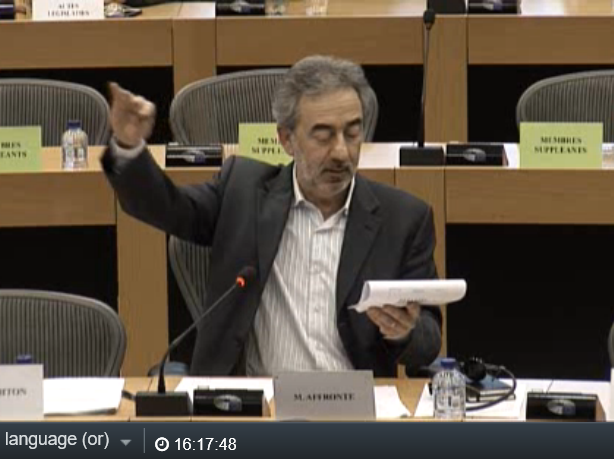 Then it was time for MEPs to ask their questions and also for further statements by Kenneth Patterson of STECF and DG MARE of the European Commission, beyond his introductory remarks at the opening.
Then it was time for MEPs to ask their questions and also for further statements by Kenneth Patterson of STECF and DG MARE of the European Commission, beyond his introductory remarks at the opening.
In opening the debate MEP Ulrike Rodust asked Dr. Froese among others whether the MAP for the Baltic would allow for continued overfishing and what to think of the management of Norway lobster in functional units.
She also wanted to know of Michael Andersen why the industry had gone on to catch flatfish in the very areas for which a moratorium had been agreed at an inclusive roundtable to protect spawning cod which was already in very bad shape.
MEP Marco Affronte then wanted to know whether Dr. Froese's estimates of recovery were already taking into account other negative factors than fishing, such as climate change and pollution. He was also interested in real world examples of stock recovery after reducing fishing pressure significantly.
Turning to Michael Andersen he took issue with the interpretation of the graphs shown and did not believe that the little reduction in fishing was sufficient as stocks had been much higher in the past and were only starting to recover. So it would be the wrong response to increase fishing after the first signs of a new build-up as the system was far from equilibrium in previous decades.
Click here to watch all of the presentations and the full debate streamed from the EP's website.
Summary by Cornelia E Nauen.









